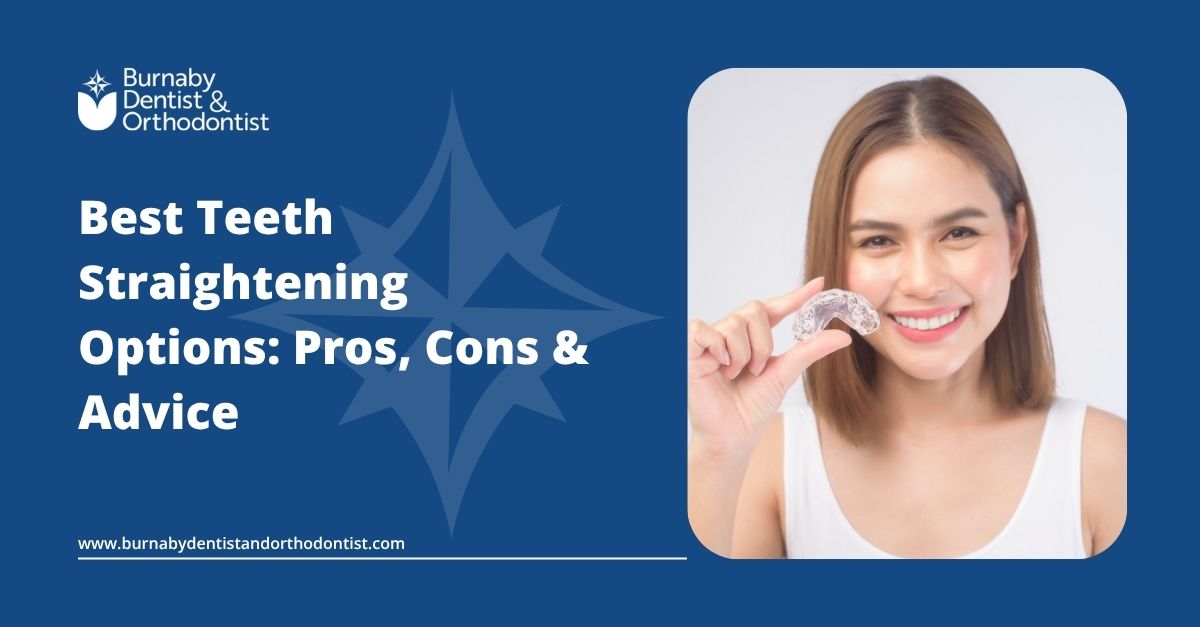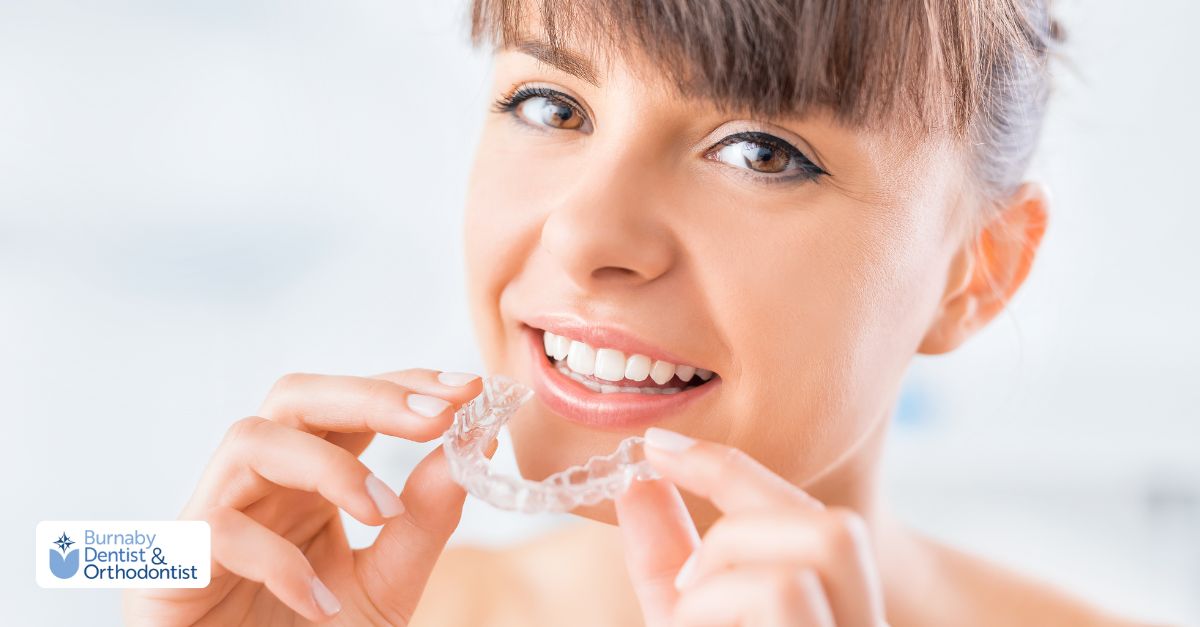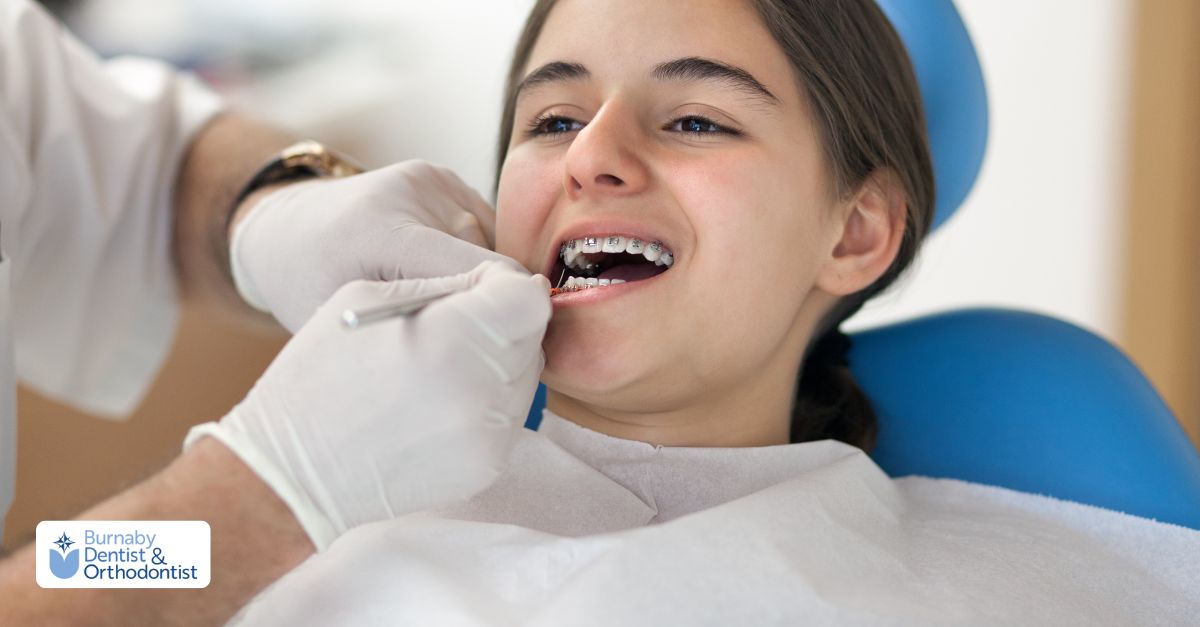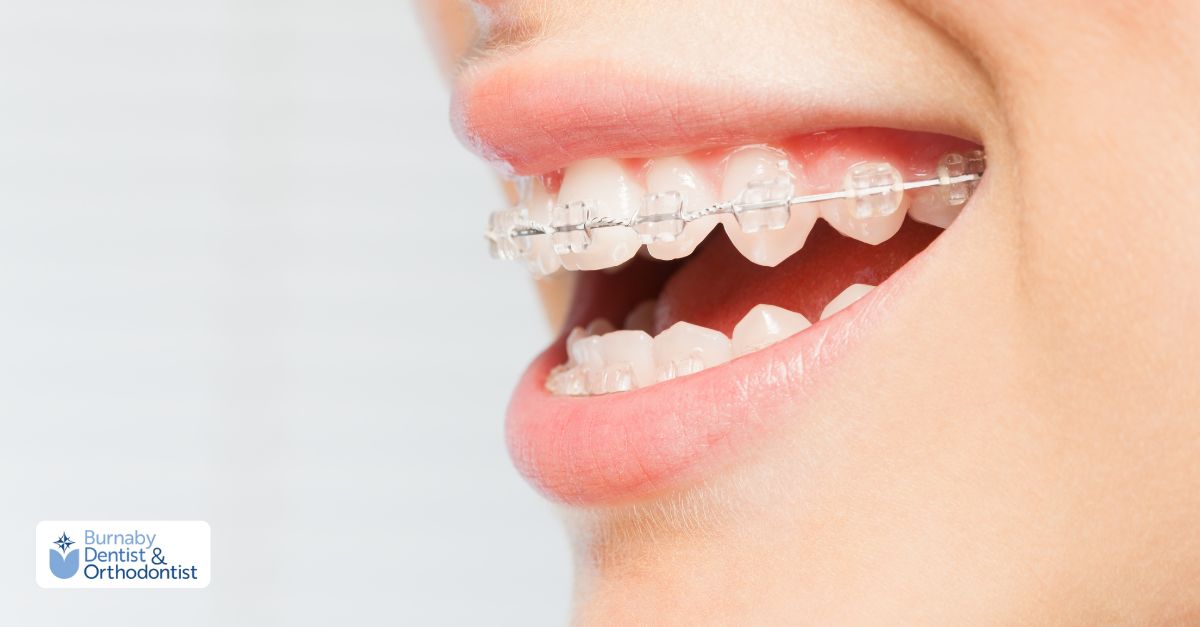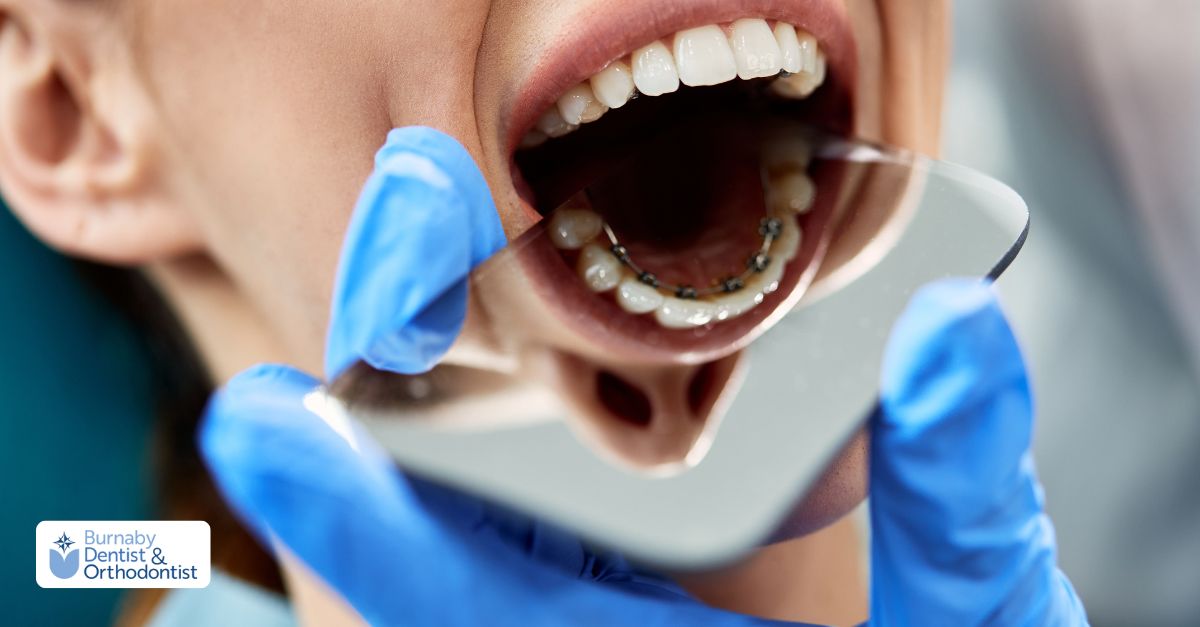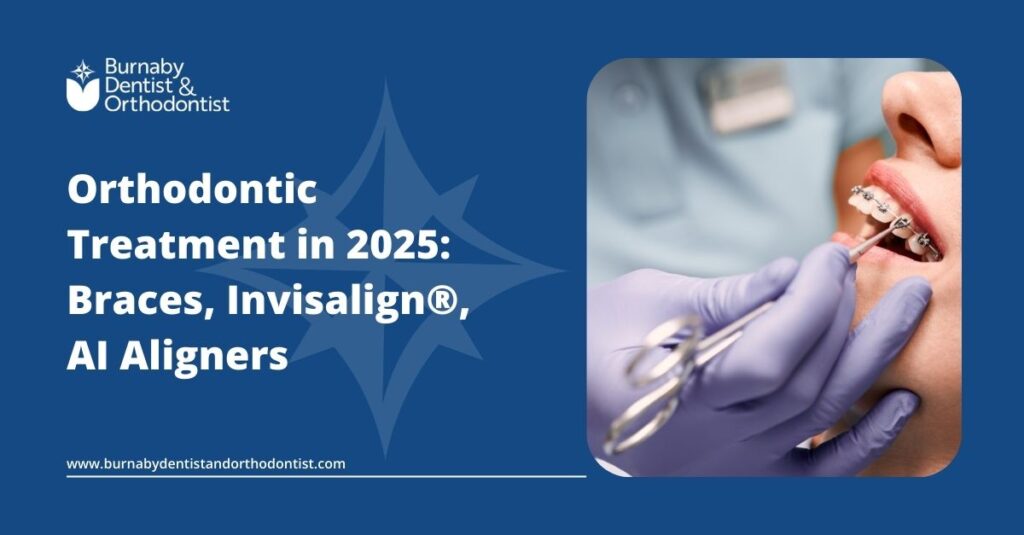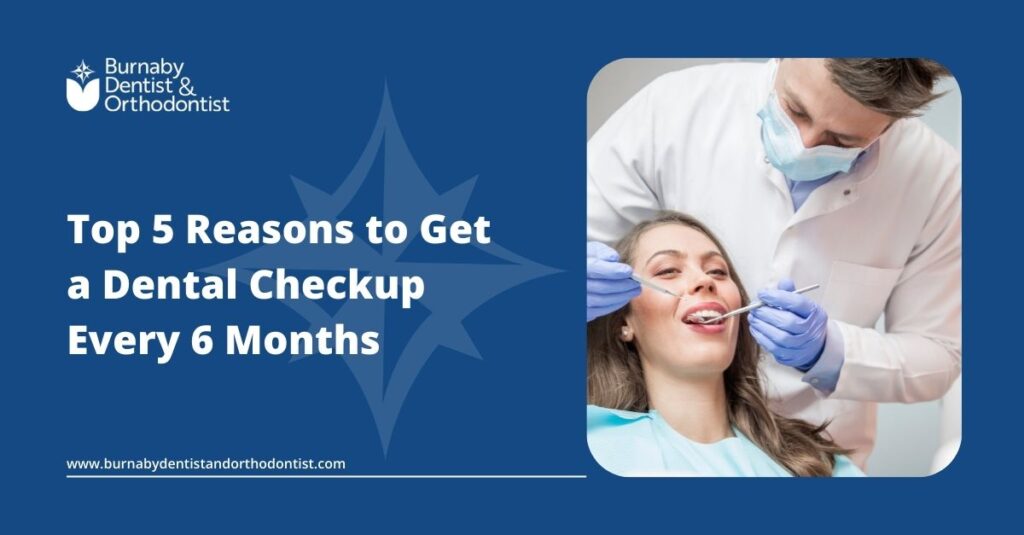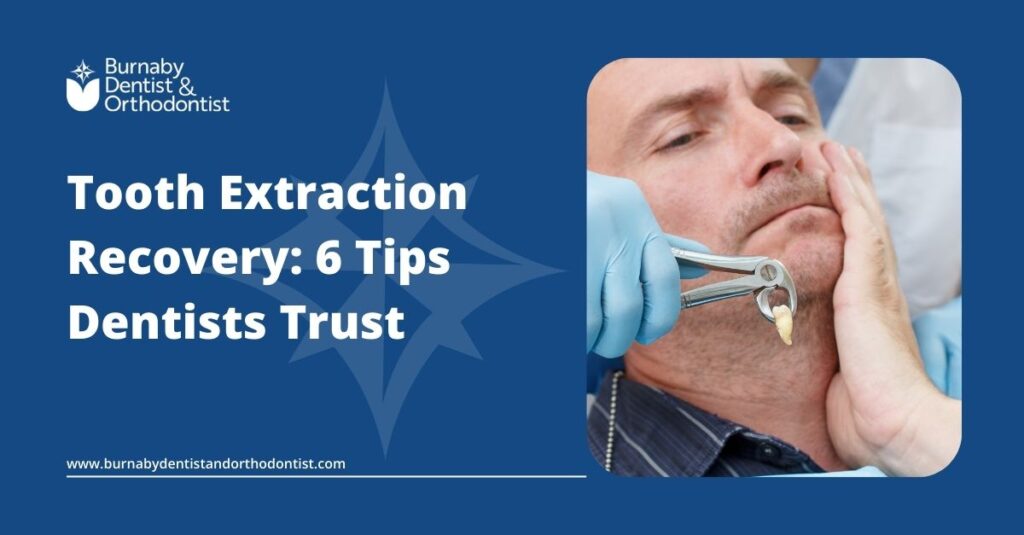Thinking about straightening your teeth? You’re not alone. A well-aligned smile can boost your confidence and support long-term oral health.
The good news: there are more choices than ever before—each with its own pros, limitations, and ideal fit. From clear aligners to traditional braces, the right option depends on your lifestyle, dental needs, and how visible (or invisible) you want your treatment to be.
At Burnaby Dentist & Orthodontist, we offer Invisalign®—a modern, discreet option that fits comfortably into most routines. In this guide, you’ll also learn about other common straightening methods to help you understand what’s possible and what might be right for you.
Here is the Quick Answer:
There’s no one-size-fits-all solution for straightening teeth. Invisalign® is a popular clear aligner system for mild to moderate alignment issues, offering flexibility and discretion.
Metal and ceramic braces are effective for more complex cases and are better suited for those who want predictable results, regardless of visibility. Lingual braces, self-ligating systems, and retainers all play different roles depending on your goals and oral condition.
Invisalign®: Clear, Comfortable, and Backed by Experience
At Burnaby Dentist & Orthodontist, we offer Invisalign®—a discreet and comfortable alternative to traditional braces. This system uses a series of custom-made, removable aligners that gradually shift your teeth into better alignment.Invisalign® is especially popular among teens and adults who want to improve their smile without the look or feel of brackets and wires. The treatment is designed to fit into your lifestyle with minimal disruption.
Advantages of Invisalign®
Here are some of the key benefits of choosing Invisalign®:
Nearly Invisible
The clear trays are hard to notice in everyday interactions—ideal for school, work, or social settings.
Removable and Convenient
You can take aligners out for meals, brushing, and flossing. That means fewer food restrictions and easier oral care.
Smooth and Comfortable
No brackets or wires—just custom-fit trays designed to sit snugly over your teeth without irritating your mouth.
Fewer Appointments Needed
Most check-ins are brief, and many adjustments happen at home as you switch trays on a set schedule.
Potential Considerations
Invisalign® isn’t the right fit for everyone. Here’s what to keep in mind:
Requires Discipline
Aligners must be worn 20–22 hours a day 1 to be effective. Skipping wear time slows down progress.
Not for Every Case
Invisalign® is ideal for mild to moderate alignment concerns. More complex issues may require fixed braces or combination treatments.
As a Platinum Invisalign® Provider, Burnaby Dentist & Orthodontist offers full digital scans, custom treatment plans, and expert support throughout your Invisalign® journey.
Best For
Teens and adults looking for a clear, removable alternative to braces—with a focus on comfort, flexibility, and expert oversight.
Traditional Metal Braces: Reliable and Proven
Traditional metal braces remain one of the most effective and time-tested options for straightening teeth. They use stainless steel brackets and archwires to gradually move teeth into the desired position through controlled pressure.
Metal braces are still the go-to choice for many orthodontic cases, especially when alignment needs are complex or severe.
Advantages of Traditional Braces
Here’s why traditional braces remain a dependable solution:
ffective for Complex Cases
They can address severe crowding, spacing, rotations, and bite misalignments more predictably than some removable systems.
Durable and Precise
Metal brackets are strong, reliable, and allow for fine adjustments over time, making them highly customizable throughout treatment.
Potential Considerations
Braces are highly effective—but not without trade-offs:
Visibility
Unlike clear aligners or ceramic options, metal braces are noticeable when you talk or smile.
Diet and Cleaning
Wearing braces requires avoiding certain foods (like sticky candies or hard snacks) and staying on top of brushing and flossing to avoid plaque buildup.
Possible Discomfort
After adjustments, some patients experience soreness in teeth, gums, or inner cheeks as the mouth adjusts to wire tension.
Best For
Children, teens, or adults with moderate to severe orthodontic needs who prioritize results and don’t mind a visible treatment option.
Ceramic (Clear) Braces: Subtle but Strong
Ceramic braces work like traditional metal braces but use tooth-coloured or clear brackets for a less noticeable appearance. They offer the same mechanics as metal braces while blending more naturally with your smile.
This option is popular among older teens and adults who want effective treatment but prefer something more discreet.
Advantages of Ceramic Braces
Here’s what makes ceramic braces appealing for many patients:
Less Noticeable Than Metal
The brackets are clear or tooth-coloured, making them visually subtler—especially
from a distance or in photos.
Effective for a Wide Range of Cases
They offer the same treatment precision as metal braces and can handle complex alignment and bite issues.
Potential Considerations
There are a few drawbacks to keep in mind:
More Fragile
Ceramic brackets are more brittle than metal ones and may chip or crack if not cared for properly.
Hygiene-Sensitive
Some parts (especially elastic ties) can stain if oral hygiene isn’t maintained or if patients frequently consume staining foods and drinks.
Slightly Larger
The brackets are often bulkier than metal, which may feel less comfortable initially for some patients.
Best For
Teens and adults who need the strength of fixed braces but want a more aesthetic option that blends into their natural tooth colour.
Lingual Braces: Hidden, Fixed, and Effective
Lingual braces use the same bracket-and-wire system as traditional braces—but they’re placed on the inner surfaces of your teeth, facing your tongue. This keeps them completely hidden from view when you speak or smile.
They’re a discreet option for those who want fixed braces but prefer to keep their treatment invisible to others.
Advantages of Lingual Braces
Here’s what sets lingual braces apart:
Fully Hidden
The brackets are tucked behind your teeth, making them invisible during everyday interactions.
Effective for Complex Alignment
Lingual braces can treat most of the same issues as traditional braces, including crowding, gaps, and bite problems.
Potential Considerations
Lingual braces may take some time to get used to:
Tongue Discomfort
Since the brackets face inward, your tongue may initially feel sore or irritated while
adjusting to their presence.
Cleaning Challenges
Oral hygiene can be trickier due to the location of the brackets, requiring more effort during brushing and flossing.
May Not Be Available Everywhere
Not all clinics offer lingual braces due to the extra training and equipment involved.
Best For
Patients who want a truly invisible option and are comfortable managing extra hygiene care and some early discomfort.
Self-Ligating Braces: Streamlined and Low-Maintenance
Self-ligating braces look similar to traditional metal or ceramic braces, but they use a special clip or sliding mechanism to hold the archwire in place—instead of elastic bands. This system is designed to reduce friction and make adjustments more efficient.
They’re often chosen for their potential to shorten appointment times and improve overall comfort.
Advantages of Self-Ligating Braces
Here’s what patients tend to like about this system:
Fewer Adjustment Appointments
Because they don’t rely on elastic ties, the brackets may require fewer in-office visits for tightening.
Smoother Movement
The low-friction design can allow for more natural tooth movement and, in some cases, shorter treatment duration.
Easier to Clean
Without elastics that trap food, self-ligating braces may be easier to keep clean—especially around brackets.
Potential Considerations
Like all fixed braces, there are a few drawbacks:
Still Visible
While they may look slightly more streamlined, self-ligating braces are still noticeable—especially if metal brackets are used.
Not Universally Offered
This type of system isn’t available at every clinic, as it requires specific hardware and expertise.
Similar Treatment Duration
Despite some claims, studies show that treatment length is often comparable to traditional braces, especially in complex cases.
Best For
Patients who want fixed braces with the convenience of fewer appointments and slightly easier maintenance—but aren’t concerned about visibility.
Retainers: Essential for Maintenance, Sometimes Minor Correction
Retainers are usually worn after orthodontic treatment to keep teeth from shifting back to their original positions. In some cases, they may also be used on their own to correct very mild crowding or relapse.
They’re an important part of long-term smile stability—and in certain cases, a simple alternative to full re-treatment.
Advantages of Retainers
Here’s why retainers matter in orthodontic care:
Nearly Invisible
Most retainers are clear and custom-fit, making them very discreet to wear day or night.
Low Maintenance
They’re easy to remove, clean, and wear as needed—especially compared to fixed appliances.
Useful for Minor Corrections
In cases of mild relapse or slight crowding, retainers may help make small alignment improvements without full braces or aligners.
Potential Considerations
Retainers do require consistency and realistic expectations:
Limited Movement
Retainers can’t fix moderate or complex alignment issues—only very minor ones.
Long Wear Time
To prevent shifting, retainers must often be worn for several hours daily, especially right after treatment. Some people need to wear them long-term at night.
Easy to Misplace
Because they’re removable and transparent, retainers are easy to lose or damage if not handled carefully.
Best For
Anyone completing orthodontic treatment who wants to preserve their results—or people with mild relapse who want a low-impact correction option.
At-a-Glance: Comparing Teeth Straightening Options |
||||
| Option | Visibility | Comfort | Effectiveness | Commitment |
| Invisalign® | Nearly Invisible | Very High | Moderate–High | Very High (Worn Daily) |
| Metal Braces | Visible | Moderate | Very High | High |
| Ceramic Braces | Less Noticeable | Moderate | Very High | High |
| Lingual Braces | Completely Hidden | Lower (Initially) | Very High | High |
| Self-Ligating Braces | Visible | Slightly Higher | High | High |
| Retainers | Nearly Invisible | High | Limited (Minor Cases) | Very High (Nightly Use) |
Expert Tips for Choosing the Right Option
Straightening your teeth isn’t one-size-fits-all. Before deciding, consider the following expert insights to help you choose the option that fits your needs best:
Match the Treatment to Your Case
If your alignment issues are mild to moderate, clear aligners like Invisalign® may be a good fit. For more complex bite or crowding issues, fixed braces may be recommended—even if through referral.
Think About Visibility
If you’re concerned about appearance during treatment, clear aligners, ceramic braces, or lingual braces may be worth exploring. Metal braces remain visible but effective.
Commitment Affects Results
Aligners and retainers require strict, daily wear. If you’re likely to forget or remove appliances often, fixed braces may offer better results.
Know What the Clinic Offers
At Burnaby Dentist & Orthodontist, Invisalign® is our primary in-house orthodontic solution. If another option is better suited, we’ll guide you toward the right next step—even if that includes a specialist referral.
Plan for the Retainer Phase
Whatever option you choose, wearing retainers after treatment is critical to keeping your results. Ask how long you’ll need them and whether fixed or removable retainers are best for your case.
Aftercare Overview: What Comes After Straightening?
Your orthodontic journey doesn’t end when your aligners or braces come off. The aftercare phase is just as important for maintaining long-term results and protecting your oral health.
Here’s what to expect depending on your treatment type:
If You Used Clear Aligners
Stick to your schedule for switching trays, and wear each aligner as prescribed. Once treatment is complete, your dentist will fit you for a retainer to help maintain your new alignment.
If You Had Fixed Braces
Routine office visits are required during treatment for wire adjustments. Once complete, you’ll transition to a retainer phase to keep your teeth from shifting back over time.
For Everyone—Retention Is Key
Regardless of which straightening method you use, retainers are essential. Most patients need to wear retainers daily at first, then nightly long term. They’re a small but critical part of preserving your results.
Why Choose Burnaby Dentist & Orthodontist?
Choosing how to straighten your teeth is a big step—but choosing who guides you through it matters just as much. At Burnaby Dentist & Orthodontist, we provide personalized care, clear information, and expert support from consultation through aftercare.
Here’s what makes our team stand out when it comes to Invisalign® and smile-focused orthodontic care:
Digital Scans From Start to Finish
We use in-house 3D imaging and digital scanning to map out your Invisalign® treatment precisely—no messy impressions, no guesswork. It’s a more comfortable, accurate way to begin your smile journey.
Appointments That Respect Your Time
We understand how busy life can be. Our team will work with you to schedule visits at times that suit your routine, so your orthodontic care stays manageable and stress-free.
Experience With a Range of Alignment Cases
From minor spacing to moderate bite correction, we’ve helped patients with diverse alignment needs using Invisalign®. Not sure if it’s right for you? We’ll walk you through your options honestly and help you plan accordingly.
Ongoing Support Beyond the Aligners
We don’t stop at straightening. Once your treatment is complete, we’ll guide you through retainer wear, hygiene habits, and routine check-ups—so your results last for the long term.
Conclusion: Take the Next Step Toward a Healthier, Straighter Smile
There are many ways to straighten your teeth—but only one smile that’s yours. Whether you’re just starting to explore your options or looking for a discreet solution that fits your lifestyle, Invisalign® offers a comfortable and modern way to move forward.
At Burnaby Dentist & Orthodontist, we provide trusted Invisalign® care—from initial consultation and digital scans to long-term retention and smile maintenance. If Invisalign® isn’t the best fit for your needs, we’ll help guide you to the right next step with transparency and expertise.
Ready to explore your options? Book a consultation and let our team help you build a plan that supports your smile goals and oral health.
What makes Invisalign® different from braces?
Invisalign® uses a series of clear, removable trays to shift teeth, while braces use fixed brackets and wires. Invisalign® is more discreet and often more comfortable for mild to moderate alignment issues.
Can I eat and drink while wearing Invisalign®?
No. Aligners should be removed when eating or drinking anything other than water. This helps prevent damage to the trays and supports oral hygiene.
Is Invisalign® painful?
Most people experience mild pressure when switching to a new tray, especially during the first few days. There are no wires or brackets, so irritation is usually minimal.
Who is a good candidate for Invisalign®?
Teens and adults with mild to moderate crowding, spacing, or bite issues who can wear aligners consistently are typically good candidates.
Does Burnaby Dentist & Orthodontist offer Invisalign®?
Yes. We are a Platinum Invisalign® Provider, offering full digital assessments, custom treatment plans, and ongoing support throughout your care.

